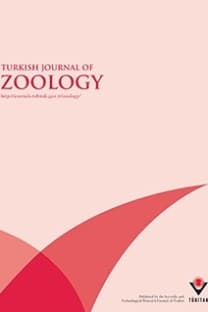Transmission of Microsporidium sp. between different generations of Crepidopdera aurata (Coleoptera: Chrysomelidae)
Transmission of Microsporidium sp. between different generations of Crepidopdera aurata (Coleoptera: Chrysomelidae)
___
- Agnew P, Becnel JJ, Ebert D, Michalakis Y (2003). Symbiosis of microsporidia and insects. In: Bourtzis K, Millar TA, editors. Insect symbiosis. Boca Raton, FL, USA: CRC Press, pp. 145-163.
- Becnel JJ, Andreadis TG (1999). Microsporidia in insects. In: Wittner M, Weiss LM, editors. The Microsporidia and Microsporidiosis. Washington DC, USA: ASM Press, pp. 447-501.
- Brooks WM (1988). Entomogeneous protozoa. In: Ignoffo CM (editor). Handbook of Natural Pesticides. Boca Raton, FL, USA: CRC Press, pp. 1-149.
- Hausmann K, Hülsmann N, Radek N (2003). Protistology. 3rd completely revised edition. E. Schweizerbart’sche Verlagsbuchhandlung (Nägele u. Obermiller). Berlin, Stuttgart, Germany: ISBN 3–510–65208–8, hardback, pp 379.
- Lipa JJ, Hokkanen HMT (1992). Nosema meligethi I. & R. (Microsporida) in populations of Meligethes spp. in Europe. Biocontrol Science and Technology 2: 119-125.
- Malone LA, Wigney PJ (1980). The distribution of Nosema carpocapsae, a protozoan pathogen of the codling moth, Cydia pomonella (Lepidoptera: Tortricidae), in New Zealand. New Zealand Entomologist 7: 151-153.
- Rosicky B (1951). Nosematosis of Otiorrhynchus ligustici, II. The influence of the parasitation by Nosema otiorrhynchi W. on the susceptibility of the beetles to insecticides. Vestnik ceskoslovenskogo Zoologickoj Spolecnosti 15: 219-230.
- Sprague V, Becnel JJ, Hazard EI (1992). Taxonomy of phylum microspora. Critical Reviews in Microbiology 18: 285-395.
- Urban J (2011). Occurrence, bionomics and harmfulness of Crepidodera aurata (Marsh.) (Coleoptera, Alticidae). Acta Universitatis Agriculturae et Silviculturae Mendelianae Brunensis 59: 263-278.
- Weiser J (1961). A new microsporidian from the bark beetle Pityokteines curvidens Germ. (Col., Scolyt.) in Czechoslovakia. Journal of Insect Pathology 3: 324-329.
- Yaman M (2007). Distribution of Nosema meligethi I. & R. (Microsporida) in populations of Meligethes aeneus (Coleoptera: Nitidulidae) in Turkey. Entomological Research 37: 298-301.
- Yaman M (2008). First results on the distribution of Nosema chaetocnemae (Microspora) in the populations of Chaetocnema tibialis (Coleoptera, Chrysomelidae) in Turkey. Turkish Journal of Parasitology 32: 94-98.
- Yaman M, Ertürk Ö (2016). Isolation, identification and insecticidal effects of entomopathogenic bacteria from the willow flea beetle, Crepidodera aurata (Coleoptera; Chrysomelidae). Progress in Plant Protection 56: 225-229.
- Yaman M, Algı G, Güner BG, Ünal S (2015). Distribution and occurrence of microsporidian pathogens of the willow flea beetle, Crepidodera aurata (Coleoptera, Chrysomelidae) in North Turkey. Entomologica Fennica 26: 171-176.
- Yaman M, Eroğlu M, Radek R (2016). Occurrence of a microsporidium in the predatory beetle Calosoma sycophanta L. (Coleoptera: Carabidae). Turkish Journal of Agriculture and Forestry 40: 420-424.
- Yaman M, Algı G, Radek R (2019a). Morphological, ultrastructural and molecular identification of a new microsporidian pathogen isolated from Crepidodera aurata (Coleoptera, Chrysomelidae). Turkish Journal of Zoology 43: 407-415.
- Yaman M, Uzuner S, Güner BG, Ayar Ö, Ertürk Ö et al. (2019b). Distribution of microsporidial infection in the predator beetle, Calosoma sycophanta (Coleoptera:Carabidae)-rearing laboratories in Turkey. Turkish Journal of Agriculture and Forestry 43: 586-592.
- ISSN: 1300-0179
- Yayın Aralığı: 6
- Yayıncı: TÜBİTAK
Kálmán SZANYI, Antal NAGY, Attila MOLNÁR, László József SZABÓ, Szabolcs SZANYI
Omid MIRSHAMSI, Mahrad NASSIRKHANI, Zahra LATIFI
Katarina BREKA, Imre KRIZMANIĆ, Tanja VUKOV, Srdjan STAMENKOVIĆ
Gökhan OTO, Saadet BELHAN, Fatih Çağlar ÇELİKEZEN, Emin ŞENGÜL, Dursunali ÇINAR, Gizem ESER, Serkan YILDIRIM
Katarına BREKA, Imre KRIZMANIC, Tanja VUKOV, Srdjan STAMENKOVIC
Kálmán SZANYI, Antal NAGY, Attıla MOLNÁR, László József SZABÓ, Szabolcs SZANYI
Serkan YILDIRIM, Fatih Çağlar ÇELİKEZEN, Saadet BELHAN, Gökhan OTO, Gizem ESER, Emin ŞENGÜL, Dursunali ÇINAR
